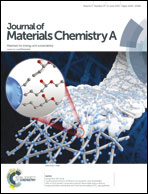Octahedral high voltage LiNi0.5Mn1.5O4 spinel cathode: enhanced capacity retention of hybrid aqueous capacitors with nitrogen doped graphene
Abstract
A new type of aqueous hybrid supercapacitor has been constructed using electrospun octahedral high voltage LiNi0.5Mn1.5O4 spinel as the cathode material and nitrogen doped graphene (NDG) as the anode material. The structural and morphological changes of the products are investigated by X-ray powder diffraction (XRD), field emission scanning electron microscopy (FESEM) and thermogravimetric analysis (TGA/DTA). The XRD pattern indicates that the LiNi0.5Mn1.5O4 spinel is highly crystalline in nature. The electrochemical performance of LiNi0.5Mn1.5O4 and NDG was evaluated by cyclic voltammetry, galvanostatic constant current charge–discharge cycling and impedance analysis in 3 M LiNO3. The specific capacitance of the LiNi0.5Mn1.5O4/NDG asymmetric hybrid supercapacitor (HSC) cell was found to be 72 F g−1 at a current density of 0.5 mA cm−2. The HSC delivered a maximum energy density of 15 W h kg−1 at a power density of 110 W kg−1. Furthermore, it was shown that an expanded voltage window of 1.3 V could be achieved when combining a composite LiNi0.5Mn1.5O4 (cathode) and NDG (anode) in a charge balanced asymmetric capacitor. Moreover, the HSC exhibits remarkable capacity retention upon cycling indicating the significant impact on the morphology of LiNi0.5Mn1.5O4 and NDG.


 Please wait while we load your content...
Please wait while we load your content...